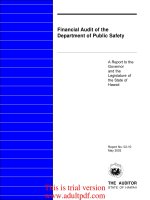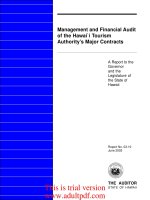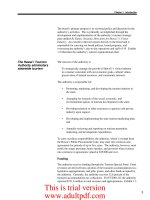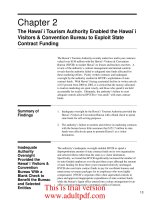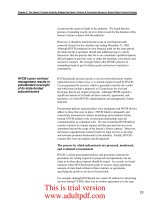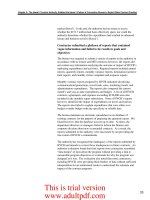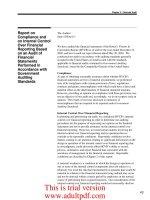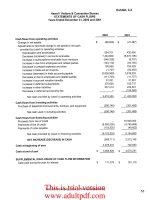Management and Financial Audit of Hawai‘i Tourism Authority’s Major Contracts A Report to the Governor and the Legislature of the State of Hawai‘i_part7 ppt
Bạn đang xem bản rút gọn của tài liệu. Xem và tải ngay bản đầy đủ của tài liệu tại đây (551.84 KB, 8 trang )
53
Responses of the Affected Agencies
Comments
on Agency
Responses
We transmitted drafts of this report to the Board of Directors of the
Hawaiʻi Tourism Authority and the authority’s interim executive director
on December 26, 2008. A copy of the transmittal letter to the board
chair is included as Attachment 1. A similar letter was sent to the interim
executive director. The joint response of the board chair and interim
executive director is included as Attachment 2.
The Hawaiʻi Tourism Authority replied that it “is committed to
addressing the points raised by the audit, . . . and is in the process of
developing an operational plan to address the audit’s ndings and
recommendations.” The authority provided information to clarify a
number of points, which neither contradict nor change our ndings and
recommendations. For example, the HTA reiterated that:
Its planning process includes both a short-term approach through •
its annual budget process and a longer-term perspective through
the Hawai‘i Tourism Strategic Plan (TSP);
Its overall role in marketing is to create a brand image for •
the destination and use the marketing effectiveness study by
TNS Research to objectively measure the performance of its
marketing programs and contractors to impact Hawai‘i’s brand
awareness as a favorable visitor destination; and
With respect to contract management related to its marketing •
contractors—the Hawai‘i Visitors and Convention Bureau,
Hawai‘i Tourism Japan and SMG—the various issues identied
in our audit have either already been resolved or are in the
process of being reviewed and addressed.
The authority intends to “also explore the need to develop a longer
range plan of its own which would also be aligned with the [Hawaiʻi
Tourism Strategic Plan]” but believes that it has been using valid and
reliable performance measurements to successfully impact Hawaiʻi’s
brand awareness as a favorable visitor destination. (Emphasis added.)
The authority differentiates its role to promote tourism through brand
awareness efforts from tourism promotion through the direct sale
and purchase of travel products such as hotel accommodations. It
distinguishes measures of effectiveness directed at determining the
success of its marketing contractors’ efforts towards developing brand
awareness from actual bookings which are beyond the control of its
contractors. The authority decided “it would be more benecial to
This is trial version
www.adultpdf.com
54
implement an accountability system that most appropriately tracks
the success of programs in generating the desire to travel to . . .
Hawai‘i.” Because of factors beyond its control, the HTA “selected
consideration and intention to travel to Hawaiʻi as the most controllable
and measurable performance metrics” and contracted with a leading
international research company to track the impact and effectiveness of
the marketing programs in its three major markets encompassing North
America and Japan.
However, the authority’s response and clarications do not appear to
fully embrace one of the report’s important points—that HTA’s plans lack
quantiable, objective benchmarks linking the activities and resources
spent by HTA and its contractors to pre-determined outcomes in a format
that does not rely on or require industry expertise. While HTA’s response
lists available measures, such do not appear in its plans, contracts, or
reports to the public and the Legislature to provide a meaningful before
and after comparison of the effect of its deployment of state resources.
We discuss this issue in our report with reference to performance
reporting standards promulgated by the Destination Marketing
Association International (DMAI). Acknowledging the difculty of
nding direct cause-effect measures in an industry that traditionally relies
on professional judgment, we explain in detail why that is not sufcient
and show that industry leaders, such as the DMAI, not only agree but
also provide a blueprint for better accountability.
In addition, HTA’s role is not solely that of a brand marketer as suggested
in the response. The authority has a dual role as lead agency for the
development of the state-wide Hawai‘i Tourism Strategic Plan and that of
an active partner in its implementation. A prime example is its contract
for the marketing and operation of the Hawai‘i Convention Center. This
contract and related performance reports lack objectively measurable
targets, capable of demonstrating the contractor’s achievement of
predetermined benchmarks. Consequently HTA’s reports to stakeholders
reect a “trust me” approach requiring the public to rely on HTA
opinions and subjective evaluations for an accounting of taxpayer funds.
Finally, the use of performance measures is not limited to broad, agency-
level activities. Measures are useful for planning for and assessing
performance of many programs, initiatives, or projects, even of staff
members. Our report seeks to convey that objectively measured goals
and their use in assessment and reporting are hallmarks of commitment
to results in a strategically oriented agency and that HTA can benet
from adopting such an orientation.
This is trial version
www.adultpdf.com
This is trial version
www.adultpdf.com
This is trial version
www.adultpdf.com
This is trial version
www.adultpdf.com
This is trial version
www.adultpdf.com
This is trial version
www.adultpdf.com
This is trial version
www.adultpdf.com
